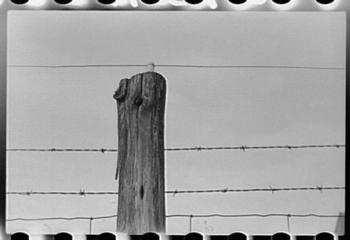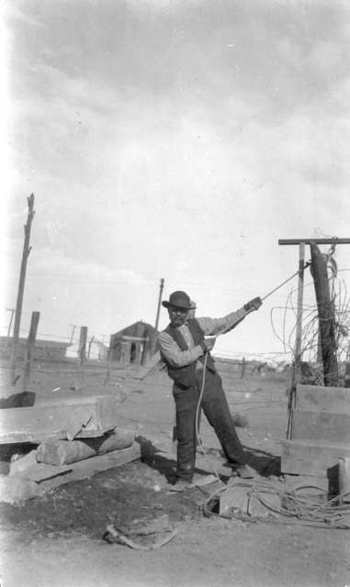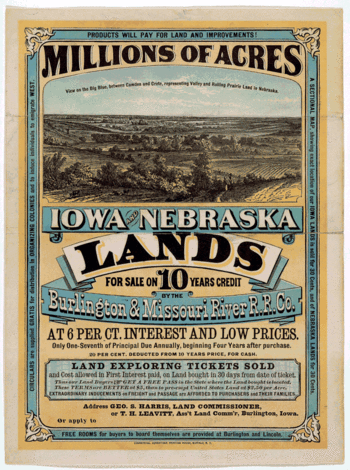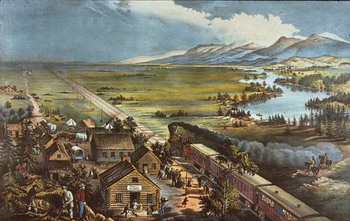JF Ptak Science Books Post 314
The story of the West getting filled up in the 1870s is a story of lines—railroad track, telegraph wires, barbed wire fences, and words on a page; big changes from disparate but related areas in technology and legislation, but when you looked at them from a distance and in the proper perspective, they all looked exactly the same.

The greatest of these lines may have been the invention of barbed wire in 1873, with Joseph Glidden, Jacob Haish and Isaac Elwood all managing to independently come upon the idea at about the same time. What barbed wire brought to the West was control and settlement. Prior to barbed wire there was open range grazing of cattle and extensive cattle drives, mainly because there was no fencing. There were also few farms due to this sort of grazing—the only thing a farm was here was in the way, and there was no recourse for the farmer to protect his
lands from a grazing herd. There was no fencing because there were no materials for the fence. Fencing was made almost entirely with lumber and stone, and on the treeless plains and the vast non-New England tracts of land, it was simply an impossible task. The introduction of barbed wire changed all of this very quickly, with thousands of miles of new fencing strung in the 1870’s alone. Fencing meant control, restriction of the use of land, of access to water, and to a way of life. It also meant that the farmer was now free to make a claim at a way of life on the plains, beginning a torrent of settlement and farms.

Another big line element of settlement were the texts (lines-on-paper) of three major acts of legislation which, over a period of just sixteen years, were responsible for moving more people than just about anything else in American history. The first of these was the Homestead Act of 1862. This was a revolutionary concept, legislated in 1358 words, effectively turning over 270 million acres, or about 8 percent of the country, of public lands to private citizens (“actual settlers of the public domain”). A claim could be made for a farm of 160 acres, for free, provided a structure was built on the land and it was maintained for five years. One could buy the parcel outright for $1.25 an acre as well. Next was the Desert Land Act of 1877 which opened drier lands, selling 640 acres at $1.25 an acre with three years to pay, so long as the land was irrigated by the end of the three years. Land that was deemed "unfit for farming" was sold to those who might want to "timber and stone" (logging and mining) upon the land with the third major piece of legislation, the Timber and Land Act of 1878. The act was used by speculators who were able to get great expanses declared "unfit for farming" allowing them to increase their land holdings at minimal expense. The Homestead Act alone accounted for the creation of almost 400,000 farms in the West by 1890. Farms meant parceling out land, "settling" it, having people on it, waiting when they weren't working.

Settlement was dramatically increased by the written and published promises and speculations of mineral wealth—not necessarily just by the introduction of miners, but by securing the lands from and removing its Indian owners. The Custer expedition into the Black Hills in 1873, for example, reported some hope for finding gold in the sacred mountains of the Sioux. Thousands of miners responded to possibility of wealth, and Custer was again dispatched to secure safety for them in the restricted lands. This in turn lead to more settlers and coincidentally to the debacle of the Little Big Horn, which was the beginning of the end of the Siouian control over vast amounts of land. From prospectors to protection to conflict, ultimately making land more available for more people.
The spread of the railroads was also an enormous settlement factor, with the number of miles of track being laid in Texas and the Great Plains doubling in just 5 years. Not only could you get West more easily, and quickly, and with less pain and suffering, but you could also be much more easily re-supplied. 
Telegraph wires tripled, making it easier to control events: and this means from being able to respond to Indian attacks more quickly to ordering boxes of nails, or beer, or shipments of newly-invented canned food.
One of the greatest and most infamous of these lines-controlling-the-West concept were the pieces of legislation and agreements and other legal and binding documents, between the U.S. government and every Indian tribe in the U.S. Promises were made to the Indians and of course not one of these treaties were ever actually realized. It was these written lines that even the greatest of Indian scouts could not track, mainly of course because they didn’t mean one bloody thing. (The idea of words in a book, lines of words, being looked at as ‘tracks” to Indians belongs to Mr. Larry McMurtry, whose greatest of all Indian scouts, the Kickapoo Indian named Famous Shoes--from the Lonesome Dove tetralogy--could not ultimately track the words in a book as he was able to track everything else that lived in nature. Words/tracks of a treaty would’ve been ever more so impossible.)
Of course in the end all of the lines applied and enabling the closing of the West were personified by smaller and more precise lines: maps.
The full text of the "Millions of Acres" broadside is as follows:
PRODUCTS WILL PAY FOR LAND AND IMPROVEMENTS!
MILLIONS OF ACRES
CIRCULARS are supplied GRATIS for distribution in ORGANIZING COLONIES and to induce individuals to emigrate WEST.
{illustration}
View on the Big Blue, between Camden and Crete, representing Valley and Rolling Prairie Land in Nebraska.
A SECTIONAL MAP, showing exact location of our IOWA LANDS is sold for 30 Cents, and of NEBRASKA LANDS for 30 Cents.
IOWA AND NEBRASKA
LANDS
FOR SALE ON 10 YEARS CREDIT
BY THE
Burlington & Missouri River R. R. Co.
AT 6 PER CT. INTEREST AND LOW PRICES.
Only One-Seventh of Principal Due Annually, beginning Four Years after purchase.
20 PER CENT. DEDUCTED FROM 10 YEARS PRICE, FOR CASH.
LAND EXPLORING TICKETS SOLD
and Cost allowed in First Interest paid, on Land bought in 30 days from date of ticket.
Thus our Land Buyers GET A FREE PASS in the State where the Land bought is located.
These TERMS are BETTER at $5. than to pre-empt United States Land at $2.50 per Acre.
EXTRAORDINARY INDUCEMENTS on FREIGHT and PASSAGE are AFFORDED TO PURCHASERS and THEIR FAMILIES.
Address GEO. S. HARRIS, LAND COMMISSIONER,
or T. H. LEAVITT, Ass't Land Comm'r, Burlington, Iowa.
Or apply to
FREE ROOMS for buyers to board themselves are provided at Burlington and Lincoln.
COMMERCIAL ADVERTISER PRINTING HOUSE, BUFFALO, N. Y.



"Oh, the farmers and the ranchers should be friends!"
Sorry for breaking into song, but your discussion of the development of barbed wire has this one stuck in my head, for the rest of the night, I fear.
Posted by: Betsy | 16 October 2008 at 11:43 PM